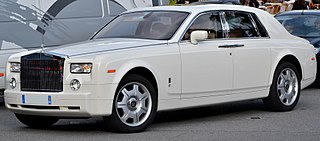
The Rolls-Royce Phantom is a full-sized luxury saloon car made by Rolls-Royce Motor Cars. Launched in 2003, it was the first Rolls-Royce developed and introduced after BMW purchased the right to use the Rolls-Royce name and logo in 1998. It was the seventh Rolls-Royce design to use the Phantom nameplate.

The Rolls-Royce Silver Cloud is a luxury automobile produced by Rolls-Royce Limited from April 1955 to March 1966. It was the core model of the Rolls-Royce range during that period. The Silver Cloud replaced the Silver Dawn and was, in turn, replaced by the Silver Shadow. The John P. Blatchley design was a major change from the pre-war models and the highly derivative Silver Dawn. As part of a range rationalisation, the Bentley S1 was made essentially identical, apart from its radiator grille and badging.

The Rolls-Royce Silver Dawn is a full-size luxury car that was produced by Rolls-Royce at their Crewe works between 1949 and 1955. It was the first Rolls-Royce car to be offered with a factory built body which it shared, along with its chassis, with the Bentley Mark VI until 1952 and then the Bentley R Type until production finished in 1955. The car was first introduced as an export only model. The left hand drive manual transmission models had a column gear change, while right hand drives had a floor change by the door. In the British home market the Silver Dawn only became available from October 1953, with the introduction of the model corresponding to the Bentley R Type.

The Rolls-Royce Silver Ghost name refers both to a car model and one specific car from that series. Originally named the "40/50 h.p." the chassis was first made at Royce's Manchester works, with production moving to Derby in July 1908, and also, between 1921 and 1926, in Springfield, Massachusetts, USA. Chassis no. 60551, registered AX 201, was the car that was originally given the name "Silver Ghost". Other 40/50 hp cars were also given names, but the Silver Ghost title was taken up by the press, and soon all 40/50s were called by the name, a fact not officially recognised by Rolls-Royce until 1925, when the Phantom range was launched.

The Bentley Mark VI is an automobile from Bentley which was produced from 1946 until 1952.

The Bentley R Type is the second series of post-war Bentley automobiles, produced from 1952 to 1955 as the sucessor the Mark VI. Essentially a larger-boot version of the Mk VI, the R type is regarded by some as a stop-gap before the introduction of the S series cars in 1955. As with its predecessor, a standard body was available as well as coachbuilt versions by firms including H. J. Mulliner & Co., Park Ward, Harold Radford, Freestone and Webb, Carrosserie Worblaufen and others.
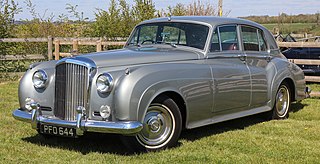
The Bentley S2 is a luxury car produced by Bentley from 1959 until 1962. The successor to the S1, it featured the new Rolls-Royce–Bentley L-series V8 engine and improved air conditioning made possible by that engine's increased output. Power steering was also standard, and a new dashboard and steering wheel were introduced. Some early S2s were built with the earlier S1 dashboard.

The Silver Wraith was the first post-war Rolls-Royce. It was made from 1946 to 1958 as only a chassis at the company's Crewe factory, its former Merlin engine plant, alongside the shorter Bentley Mark VI. The Bentley was also available as a chassis for coachbuilders, but for the first time could be bought with a Rolls-Royce built Standard Steel body. The use of the name "wraith" coincided with the established tradition of naming models after "ghosts".
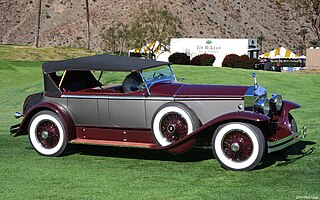
The Rolls-Royce Phantom was Rolls-Royce's replacement for the original Silver Ghost. Introduced as the New Phantom in 1925, the Phantom had a larger engine than the Silver Ghost and used pushrod-operated overhead valves instead of the Silver Ghost's side valves.

The Rolls-Royce Phantom II was the third and last of Rolls-Royce's 40/50 hp models, replacing the New Phantom in 1929. It used an improved version of the New Phantom engine in an all-new chassis. A "Continental" version, with a short wheelbase and stiffer springs, was offered.

The Rolls-Royce Phantom III was the final large pre-war Rolls-Royce. Introduced in 1936, it replaced the Phantom II and it was the only V12 Rolls-Royce until the 1998 introduction of the Silver Seraph. It is the first of the three V12-powered Rolls-Royce Phantoms, with the 2003-2017 Rolls-Royce Phantom VII and 2018- Rolls-Royce Phantom VIII being the other two. 727 V12 Phantom III chassis were constructed from 1936 to 1939, and approximately 650 have survived. Although chassis production ceased in 1939, cars were still being bodied and delivered in 1940 and 1941. The last car, though the rolling chassis was completed in 1941, was not delivered with a body to its owner until 1947. The Phantom III was the last car that Henry Royce worked on – he died, aged 70, a year into the Phantom III's development.

The Bentley 3½ Litre was a luxury car produced by Bentley from 1933 to 1939. It was presented to the public in September 1933, shortly after the death of Henry Royce, and was the first new Bentley model following Rolls-Royce's acquisition of the Bentley brand in 1931.

The Rolls-Royce Wraith was built by Rolls-Royce at their Derby factory from 1938 to 1939 and supplied to independent coachbuilders as a rolling chassis.
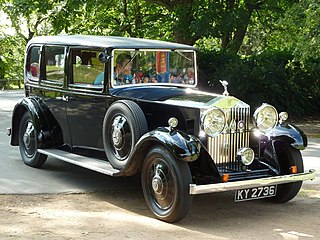
The Rolls-Royce 20/25 was the second of Rolls-Royce Ltd's pre-war entry level models. Built between 1929 and 1936, it was tremendously popular, becoming the most successful selling inter-war Rolls-Royce. Its success enabled Rolls-Royce to survive the economic difficulties of the Great Depression years and remain one of world's great brands. A total of 3,827 20/25s were produced, of which over 70% are still on the road today.

James Young Limited was a top class British coachbuilding business in London Road, Bromley, England.

The Rolls-Royce 25/30 built between 1936 and 1938 is an updated version of the 20/25 with larger engine to provide more power, as over-large bodies had often been fitted to the earlier model leading to complaints about its performance.

The Rolls-Royce 30 hp was one of four cars to be produced as a result of an agreement of 23 December 1904 between Charles Rolls and Henry Royce. Badged as a Rolls-Royce, the 30 hp was produced during 1905 and 1906 by Royce's company, Royce Ltd. at its factory in Cooke Street, Hulme, Manchester. It was sold exclusively by Rolls' motor dealership, C.S.Rolls & Co., at a price of GBP 890. The engine was exhibited at the Paris Salon in December 1904, along with the 10 hp, 15 hp and 20 hp models.
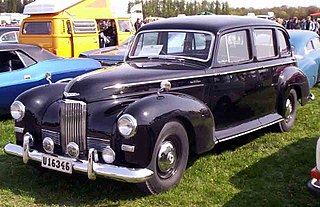
The Humber Pullman is a four-door limousine which was introduced by the British Humber company in 1930 as a successor to the Humber 20/65 hp and long-wheelbase version of the Humber Snipe.

The Carlton Carriage Company was a highly respected London coachbuilder that provided bespoke coachwork for some of the finest car makers of the 1920s and 1930s. They are best known for their drophead coupes which are archetypal designs of the British Jazz Era.

Daimler DE was a series of chassis made by the Daimler Company from 1946 until 1953. DE chassis were the basis for Daimler's largest and most expensive cars at the time. There were two versions: the short-wheelbase DE 27 with the Daimler Twenty-seven straight-six engine, and the long-wheelbase DE 36, the last Daimler Straight-Eight, with the Thirty-six straight-eight engine. Daimler DEs, especially the DE 36 Straight-Eight, was sold to royalty and heads of state around the world, including British royalty under the royal warrant that Daimler had held since 1900.


























